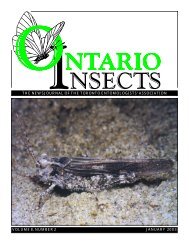1995 - Toronto Entomologists' Association
1995 - Toronto Entomologists' Association
1995 - Toronto Entomologists' Association
You also want an ePaper? Increase the reach of your titles
YUMPU automatically turns print PDFs into web optimized ePapers that Google loves.
Ontario InsectsChanges at High ParkOnJuly 2nd, I participated in a tour with100 + walkers to the western edge ofHigh Park. It was sponsered by the<strong>Toronto</strong> Historical Board and Sun Lifeof Canada. I led a TEA field trip to thepark on July 9 (see Field Trip report inthis issue - Ed.) and tagged along on anotherbutterfly walk, led by MelTintpulver, on July 30th. Here are someof my observations and comments onthe changes I've seen at High Park.New Jersey Tea (Ceanothus americaus)was once common in the Park but wasnot found on these outings. It is a majornectar source for Hairstreaks, Blues andSkippers and the larval hostplant forSpring Azures and the Mottled DuskyWing. The latter has not been seen inthe park for many years.There has also been a serious decline inBlack Oak (Quercus velutina) saplings inthe last decade. It is a mystery whythey've practically disappeared in areaswhere they were once common. Withoutthem the Edward's Hairstreak willnot survive. I learned from the leaderof the July 2nd walk (Rene Malagonl thatthe High Park Restoration Committeeplan to take out some of the Sassafrass(Sassafrass albidum) in the park and replaceit with other rarer plants of theOak woodlands.Remarkably few butterflies were seenon the July 9th and July 30th trips althoughit's interesting to note that manymale Gypsy Moths (Lymantria dispar) ,in their typical erratic flight, were seenon July 30th. It appears that there arerelatively few species now in High Parkwhen compared to earlier records. InTEA seasonal summaries from 1969-79Letters~---~there are, I believe, no records for thepark. However, from 1980-88, nine collectingseasons, ten contributors recorded22 species from the park. Noneof the species was new to the park.I can easily recall when it was not unusualto see more than 20 species in asingle afternoon. For example, I found24 species on July 8, 1959! Six speciesof Hairstreaks accounted for more than150 individuals. Two species recordedon that date, Silvery Checkerspot(Charidryas nycteis) and Meadow Fritillary(Clossiana bellona), are probably nolonger to be found in High Park.Bill Edmonds, <strong>Toronto</strong>Letters received beforethe premier issue...I would greatly appreciate receivingmore information about "OntarioInsects"D.F.]. Hilton, Bishop's University,Lennoxville, QuebecI am interested in the newsletter/journal,Ontario Insects, that will belaunched this year. Could you pleasesend me information on the cost.A. Robbie-Draward, Parks & RecreationDept., City ofWinnepeg, ManitobaHow do I get a copy of Ontario Insects?How does it compare to the ill-fatedOntario Insect Collector's News or itssuccessor? I am only guessing (and hoping)that it fills this important vacantniche.Steve Marshall, University ofGuelph,Guelph, Ontario (via e-mail)President'sMessageWell, it's been an eventful year (thisshould qualify for the "understatementof the year" award)! As you can see,the executive andboard have been busy.There have been some personnelchanges to the Board of Directors,there's this newjournal thatyou're holding,plus amendments to the constitutionto be voted on (make sure you getyour votes in), an upcoming meetingseason that looks very entertaining(thanks, Paul) and a membership whichis growing in leaps and bounds, orshould I say, hops and flights.There was also a Graduate Student Symposiumin April, an abundance of butterflycounts in Ontario this summer,three TEA field trips, and quite a numberof opportunities to interact with, andeducate, John & Jane Q. Public - certainlya lot more of them than there'vebeen in the past. My impression is thatthis reflects a genuine increase in interestof insects and entomology in thisprovince. The launch of Ontario Insectscould not have happened at abettertime!And there's never been a better time toget more involved with the TEA. Besides,if you do get more involved thenI can stop bugging you about it.Many thanks for your inquiries and thekind words. We hope the real thing livesup to your expectations. All ofyou will receivea complimentary copy ofthe premierissue to satisfy your curiousity. Subscribingto Ontario Insects is easy - join the<strong>Toronto</strong> <strong>Entomologists'</strong> <strong>Association</strong>! Seethe membership information in the mastheadon the inside of the front cover forfurther info.Phil & Pat,Editors2September, <strong>1995</strong>



